
WilliamsT
.pdf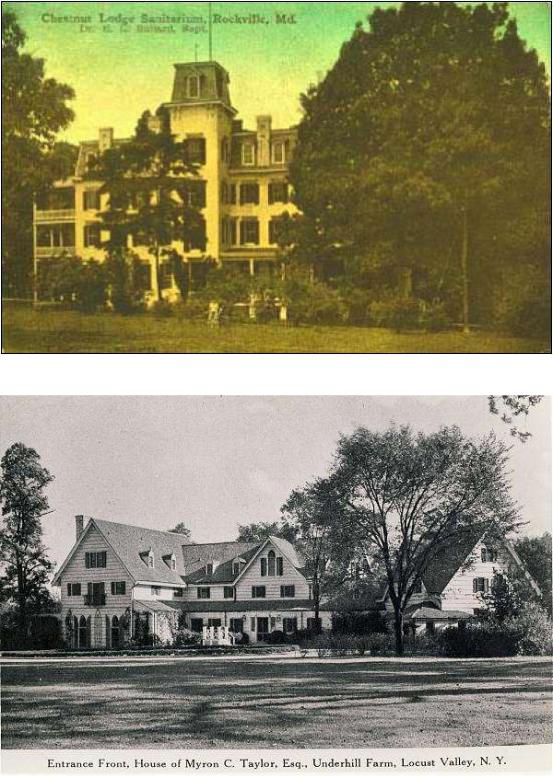
Figure 61: The Chestnut Lodge, inspiration for Lilith’s Poplar Lodge.
Figure 62: The Killingworth Mansion, Long Island, the location for the Poplar Lodge.
271
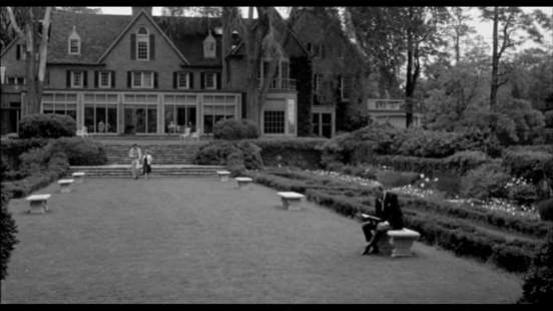
Figure 63: The Poplar Lodge, in Lilith.
The film was released to mixed reviews. Schüfftan’s photography also met with a mixed response. For Lawrence Quirk (1990: 94), ‘Eugen Shuftan’s photography is fussy, overly preoccupied with lambent but inessential nuances and details, and it commits, moreover, the sin of calling too much attention to itself and distracting from the dramatic and acting values, if any.’ In fact, Schüfftan’s photography matches the complexity of the film, with many different shifts in tones and moods. The film is at times a love story and at others a psychological drama on the verge of horror. One of the film’s stars, Jean Seberg, noted this complexity and subtlety of representations in Lilith, using a metaphor of the camera: ‘The sanitarium is not a snake pit and Lilith does not have a screaming case of insanity. She’s like a camera lens going slightly in and out of focus.’ (Seberg quoted in: Gardner, 1963) Like the schizophrenia of Lilith, Schüfftan’s lighting can similarly be characterized as schizophrenic. The many faces of Lilith are mirrored by a myriad of techniques in terms of Schüfftan’s lighting (see Figures 64-66). At times Schüfftan presents Lilith as an enigma, by using a soft focus lens and gauze to further soften the image, and to obfuscate the image of Lilith (Figure
272

64). At other times Lilith is presented as romantic through the use of a stronger key light, highlighting Seberg’s golden hair, combined with fill lights to reduce shadow (Figure 65). Elsewhere the full madness of Lilith is revealed (Figure 66). Here Schüfftan returns to full chiaroscuro effects, by using a key light from a low angle to cast shadows across the face. We can attribute such effects wholly to Schüfftan, as we know he was given free range by
Rossen, who cared little for the film’s visuals. As Cohen (1965: 5) has noted, ‘Rossen is interested primarily in story and acting and not in the photography as such.’ Confirming this,
Rossen chose to film Lilith in continuity, something which benefits the actors, but is a greater challenge for the technical crew (Gardner, 1963).
Figure 64: The enigma of Lilith.
273
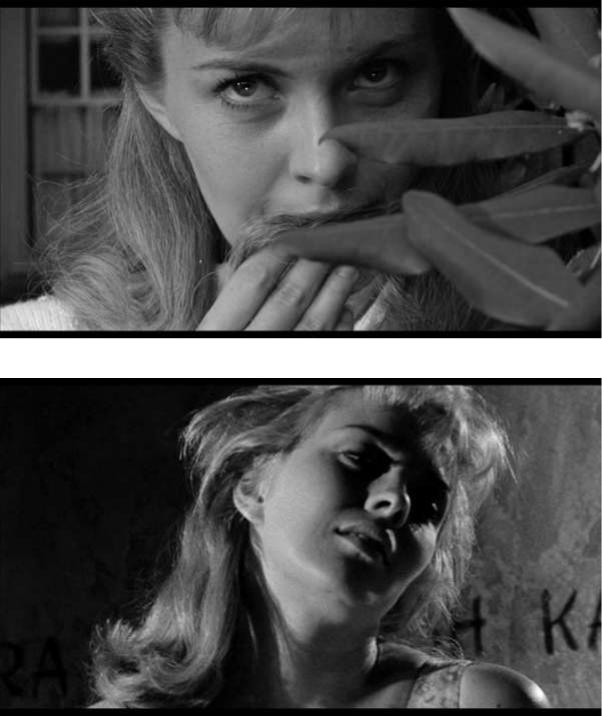
Figure 65: The romantic Lilith.
Figure 66: The madness of Lilith.
After the completion of Lilith, Schüfftan again returned to France, this time for his final collaboration with Jean-Pierre Mocky. This was for La Grande frousse/The Big Scare (also known as La Cité de l’indicible peur, 1964), a comedy of rather different order than their
274

previous collaborations. It is a black comedy, starring the comic actor Bourvil as an inspector who becomes embroiled in a murder mystery in a strange provincial town of France. Schüfftan was then reunited with Marcel Carné for Trois chambres à Manhattan, which was filmed in the studios of Paris, and on location in Manhattan. This was perhaps the last important moment of Schüfftan’s career.
Final Years: 1966-1977
Following completion on Trois chambres à Manhattan Schüfftan worked upon only two further films. The first of these, Chappaqua (1966), was directed by Conrad Rooks, and is a
‘trip film’, a semi-autobiographical account of the director’s attempt to free himself of drug addiction. Befitting the theme, the film features a variety of techniques to reproduce this drugs culture, including a mix of colour, black and white, and sepia photography. Flashbacks, hand-held camera motions and the sitar soundtrack by Ravi Shankar also combine to create an impression of psychedelia. Schüfftan’s presence on this film at the age of 80 demonstrates his continuing interest in taking risks and his forward thinking in terms of film production. Sadly however, Schüfftan’s experience on Chappaqua was not a successful one. Rooks has discussed the issue in rather cruel terms in an interview from 2006: ‘The film itself started out with a typical high-tech crew, and then we find out we’ve got a blind cameraman. And anyway, Robert Frank’s footage is so much more interesting than Schüfftan’s, that finally we just had to give up on that and just let Robert go [on].’55
Clearly Schüfftan could not continue his career with failing sight, and so made only one further film, which alongside Chappaqua provided a rather ignominious end to his tumultuous career. The film was the entirely forgotten Der Arzt stellt fest…/The Doctor Says
55 Available as an extra feature on the Dutch DVD release of Chappaqua from ‘warped vision’.
275
(Aleksandar Ford, 1966), a Swiss abortion documentary, which was re-cut and re-packaged for American release as an exploitation film. It once more demonstrates Schüfftan’s unflinching desire to remain current, but nonetheless provides a rather sad end to Schüfftan’s career. The European cameraman who couldn’t work in America, who became the American cameraman who couldn’t work in Europe, who became the cameraman who won an Academy Award but was never allowed full access to the union, finally became a blind cameraman.
At the time of his retirement Schüfftan had been suffering ill health for approximately twenty years. With this in mind, it is remarkable that he had continued work until the age of 80. Schüfftan and his wife settled for retirement at their home on West 71st Street, New York, the city where their close friends Siegfried and Lili Kracauer still resided. Sadly, in November of that same year, 1966, Siegfried Kracauer passed away. His wife followed in 1971. Even less is known of Schüfftan’s years in retirement than of his years struggling in the film industry.
In 1975, Schüfftan became the first recipient of the Billy Bitzer Award, which had been created in honour of the pioneering cinematographer known for his work with D.W Griffiths. Bitzer had originally set up the New York union which evolved into the 644 division which finally allowed Schüfftan membership. It was this union branch which established the Bitzer Awards and honoured Schüfftan in 1975.
Schüfftan was again honoured in March 1977 at a screening and discussion of Menschen am Sonntag, held at the Deutsches Haus at New York University, and organized by Kathinka Dittrich van Weringh. The elderly Schüfftan and his wife were in attendance, as was the eminent New York film critic Susan Sontag (Dittrich van Weringh, 2003: 148-150).
276
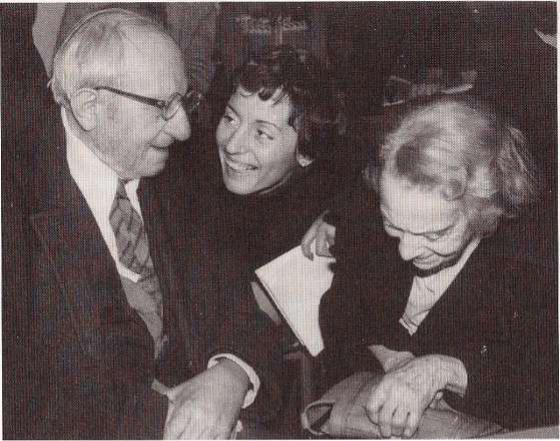
Figure 67: Eugen Schüfftan at a press screening of Menschen am Sonntag, in March 1977. (Left to right: Eugen Schüfftan, Kathinka Dittrich van Weringh, Marlise Schüfftan.)
Only a few months later, on 6th September 1977, Eugen Schüfftan died in the DeWitt Nursing Home, New York, at the age of 91. He was recognized by an obituary published by The New York Times on 12th September. Kathinka Dittrich van Weringh has recalled attending Schüfftan’s funeral on the Upper West Side of New York, the city the Schüfftan had eventually come to know as home. According to Dittrich van Weringh, only 10 to 15 people were in attendance (2003: 150).
277
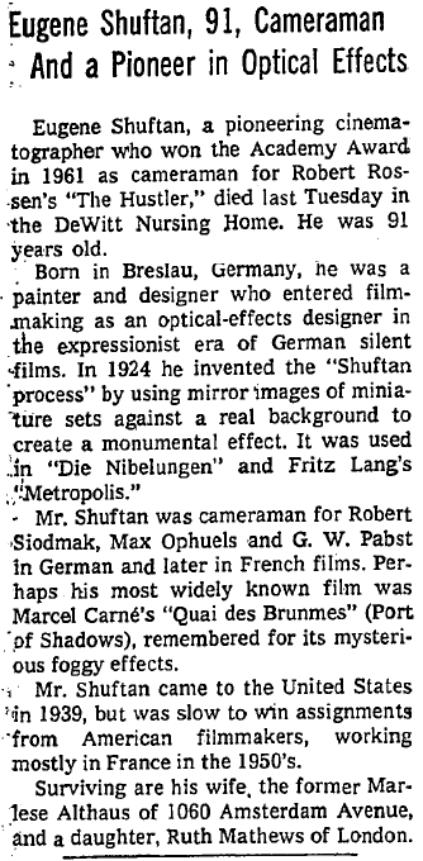
Figure 68: The obituary of Eugen Schüfftan, published by The New York Times on 12 September 1977.
278
279

Part Two
Case Study
Cityspace in the New York City Trilogy
Passion for architectural space cannot be dissociated from passions for light.
- Peter Greenaway (Kruth, 1997: 73)
Introduction
As we know, Schüfftan made his major breakthrough in the film industry, in 1927, by creating a special effects process which contributed to the successful realization of the vast futuristic cityscape of Fritz Lang’s Metropolis. In this film the city became a vision of Modernity in its most dystopian form, enforcing a total uniformity of society. Schüfftan’s films from the 1960s addressed in this chapter, Something Wild, The Hustler and Trois chambres à Manhattan, all filmed on location in Manhattan, mark the first time in
Schüfftan’s career since Metropolis that the city comes to play such a major representational
280
